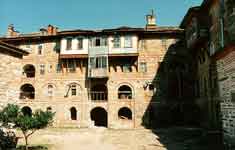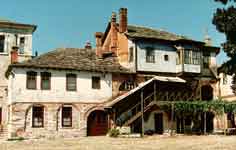.
The Monastery of Great Lavra (Greek: Μονή Μεγίστης Λαύρας) is the first monastery built on Mount Athos. It is located on the southeastern foot of the Mount at an elevation of 160 metres. The founding of the monastery in AD 963 by Athanasius the Athonite marks the beginning of the organized monastic life at Mount Athos. At the location of the monastery, there was one of the ancient cities of the Athos peninsula, perhaps Akrothooi, from which the sarcophaguses of the monastery that are in the oil storage house come from. The history of the monastery is the most complete in comparison with the history of the other monasteries, because its historical archives were preserved almost intact. It is possible that the study of these archives may contribute to the completion of the knowledge of the history of other monasteries, whose archives were partially or all of them lost.


Athos: Monastery of Great Lavra - Monastery of Great Lavra -
Founding
The founder of Great Lavra, Athanasius, began the construction of the buildings in 963, according to the will of his friend and Byzantine Emperor Nikephoros II Phokas who funded the project. Nikephoros had promised Athanasius that he would soon became a monk of Great Lavra but the circumstances and his death canceled those plans. However, a permanent imperial granting, which was doubled by John I Tzimiskes, allowed the integration of the buildings. The emperors gave also Grat Lavra many other lands of property including the island of Saint Eustratius and the Monastery of Saint Andreas in Thessaloniki. This led to the growth of the monks from 80 to 120.
Later history
The building project, according to the biography of saint Athanasius (11th century), began from the protective wall and continued to the church and cells. After Athanasius' death the monastery continued normally its operation. The eperors favored its development and during the 11th century there were 700 monks, while smaller monasteries had been ceded to Great Lavra. In the 14th century the monastery suffered, like all the other monasteries of Mount Athos, from Catalan and others pirates. The result of the crisis was the formation of a peculiar way of monasticism despite the objections of the official Church and the emperors. In 1574, the Patriarch of Alexandria Sylvester helped and the monastery operated again under the Cenobitic monasticism but soon the peculiar monasticism was again introduced. In 1655 the Patriarch Dionysios III donated his personal fortune who also became a monk, for the return to the cenobite but again these tries were insufficient and the peculiar monasticism remained until the 20th century (1914), when there were new tries for the return to the cenobite but without results. Since 1980 the monastery is cenobitic.
Buildings
The main church (Katholikon) was found by Athanasius who also lost his life together with other 6 workers when during the construction one of the domes fell. The architectural style of the temple is characterized by the two large areas of the chorus and the preyer. This style was then consecrated and was copied by the other monasteries. The frescoes were made in 1535 by the great painter Theophanis. However, the narthex was painted in 1854.
Northern of the preyer, there is the chapel of the Forty Martyrs of Sebaste in which there is the grave of Athanasius. Southern of the prayer, there is the chapel of Saint Nicholas, painted by Franco Cantellano, in 1560. The trapeza opposite the central entrance has a shape of cross and is the biggest on Mount Athos. Its internal is full of frescoes, painted by Theophanis or his school.
Art treasures
The library of the monastery is located behind the main church. It contains 2,116 Greek manuscripts and 165 codeces. Among them uncial manuscripts of the New Testament: Codex Coislinianus, Codex Athous Lavrentis, Uncial 049, and Uncial 0167. There are also over 20,000 printed books, and about 100 manuscripts in other languages. The collection is one of the richest collections of Greek manuscripts in the world.
The vestry is behind the main church. Some of the most important artifacts are a manuscript of a gospel with a golden cover which is a gift from Nikephoros II Phokas and the list (Kouvaras) of the monks since Athanasius. There are also 2,500 icons which cover the whole history of hagiography of the second millennium.
References
* Papyrus Larousse Britannica 2006
See also
* Lavra
* Prodromos Skete, belonging to the Great Lavra
Monastery of Great Lavra Information and Images
Greek page about paintings of Panagia, Artemis and Eileithyia in Megisti Lavra
Η Παναγία, η Αρτεμις και η θεά του τοκετού Ειλείθυια συνυπάρχουν στην Ιερά Μονή Μεγίστης Λαύρας
|
|||
|
Megistis Lavras · Vatopediou · Iviron · Hilandariou · Agiou Dionysiou · Koutloumousiou · Pantokratora · Xiropotamou · Zografou · Dochiariou Karakalou · Philotheou · Simonos Petra · Agiou Pavlou (St. Paul) · Stavronikita · Xenofontos · Grigoriou · Esphigmenou · Panteleimona (Rossikon) · Konstamoniti |
| Ancient Greece
Science, Technology , Medicine , Warfare, , Biographies , Life , Cities/Places/Maps , Arts , Literature , Philosophy ,Olympics, Mythology , History , Images Medieval Greece / Byzantine Empire Science, Technology, Arts, , Warfare , Literature, Biographies, Icons, History Modern Greece Cities, Islands, Regions, Fauna/Flora ,Biographies , History , Warfare, Science/Technology, Literature, Music , Arts , Film/Actors , Sport , Fashion --- |
Retrieved from "http://en.wikipedia.org/"
All text is available under the terms of the GNU Free Documentation License


